“The museum statistics published by the newspapers are always interesting. And they confirm our achievement. But I believe that the value of a museum like Brera goes far beyond the total numbers of visitors, profits from ticket sales or economic impact. Every big city has a hospital and schools of excellence, but no one would say their excellence lay in their bottom line or ROI (return on investment), or their importance in attracting inward investment, because their mission is not to make money, but to create new scholarship, or to heal the sick.”
If James Bradburne’s waistcoat recalls those that Fortunato Depero designed for the Futurists who wanted to abolish moonshine, the view from his studio invites you to look for it, filtering between the roofs of the Brera palace, where the order of things is that of an eclectic and global personality. Architect, designer, curator, critic, Bradburne was born in Canada, studied in Britain and has managed institutions in Germany, Holland, the United Kingdom and Italy. Bradburne is one of 20 museum directors who in 2014 won the competition held by the then culture minister Dario Franceschini. A decision that a certain section of the intelligentsia saw as a true revolution and perhaps even the country’s shame. This was not just because it rewrote the rules of engagement, the role of museum directors, and the idea of museums’ independence. It was above all because it led to 10 men and 10 women, seven of them foreign and the others Italian, running the country’s highest cultural institutions, which perhaps no one had expected. At least in certain quarters, some people identified themselves with a different idea of museum conservation, with its symbols in Salvatore Settis and Tomaso Montanari. And champion polemicists.
“Personally I agree with a lot of the things that Settis and Montanari say, but not the catastrophic picture they paint of the state of the museums after Franceschini’s reform. The truth is they have an ideological and political agenda, while I feel the critical outlook should prevail. Perhaps other people in Italian museums go in for marketing and communication. At Brera we have focused on public engagement and scholarly success, rejecting temporary exhibitions, to pump up visitor numbers, abolishing marketing and completing the first reinstallation for all the permanent collections in 40 years. Above all, we’ve put Brera back at the heart of the city, connecting to fashion, design and music, not in imitation of museums in the English-speaking world, but as an inherent part of the character of Milan, the city of which Brera is one of the symbols, an integral part of its identity.”
Vision is a key word that Bradburne repeats, while his secretary serves coffee in a beautiful orange plastic cup. “I regret I never met Franco Russoli, for generational and geographic reasons, but I’m very much in tune with his approach to museums and their role in society. What I’m doing, together with an exceptional team, that ranges from architects to educators to my office staff, extraordinary professionals who challenge all the stereotypes of Italian cultural bureaucracy, is creating the conditions for the Milanese to be the first audience of the museum’s masterpieces. And as they are masterpieces, they need to be admired not just for five minutes but for as long as it takes for them to transform the viewer. At Palazzo Strozzi we had the labels for the works written by poets, artists, scientists and even children, and devised ideas to engage the visitor’s attention fo extended periods. Here we have enhanced the aura and the power of the masterpiece, in order to stimulate to trigger public discussion, creating a virtuous circle where the museum is part of citizens’ daily lives. After all, it was Fernanda Wittgens who championed the idea of the “living museum”. And, like her protegé Franco Russoli, she believed art was part of a museum’s mission to stay contemporary. So you don’t go to Brera in quest of absolute truth, but to get in touch with the here and now in which Caravaggio is as contemporary as Kiefer. And here I see another point of difference with Settis and Montanari: we need to be conservators, not conservatives. We have to protect works certainly – you can’t create new experiences with art if you don’t make conservation a priority, but we also need to expect more from our museums. They need to engage in a dialogue with visitors, not see them as customers, but as welcome guests and be determined to treat them as active users, informed, engaged and intelligent, not merely passive subjects, empy vessels to be filled with expert knowledge.”
Just a few months before his mandate ends – “there is still a lot do after 30 September, but never take things for granted in life, especially Italian life” – Bradburne endorses the validity of Franceschini’s reform. “He gave Brera at least some of the tools to return to its heydey in the decades after the Second War. So it has been ‘back to the future’, a chance to set Brera in the visionary and activist tradition shaped by its three great directors in the 20th century: Ettore Modigliani, Fernanda Wittgens and Franco Russoli. They were much more than just three great art historians. They were true visionaries, directors apable of making Brera a laboratory of the imagination, a crucible for contemporary society, while still respecting and preserving the legacy of the past. In short, making Brera the heart, together with La Scala, of one of the most important cities in the world.”
James M. Bradburne architetto, designer e museologo anglo-canadese, si è laureato all’AA di Londra e ha conseguito il dottorato in Museologia all’Università di Amsterdam. Già direttore generale della Fondazione Palazzo Strozzi (2006-2015), attualmente è direttore generale della Pinacoteca di Brera e della Biblioteca Nazionale Braidense.


